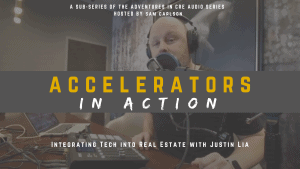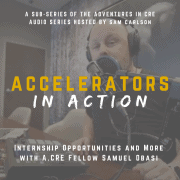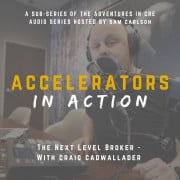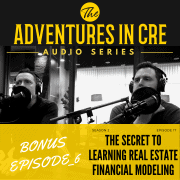Integrating Tech into Real Estate with Justin Lia
Commercial real estate isn’t the fastest to adopt the newest tech compared to other fields. Doing so, however, could increase returns, lower operating expenses, and reduce workload. In this Accelerators in Action episode, listen as Sam Carlson speaks on this topic with RE professional working to integrate tech with real estate, Justin Lia.
Justin Lia currently helps people buy, sell, and run real estate. He works as both a consultant and a broker. He has a degree and license in engineering and previously worked in constructing modeling and constructing large structures such as retaining walls and other geotechnical models. He works with giant REITS, the biggest PE companies in the world, and more to bring a detailed perspective on how to add value to deals.
This is our 7th episode in a growing sub-series of interviews with commercial real estate professionals. This Accelerators in Action sub-series tells the stories of CRE professionals at all stages of their career, from students to senior-level professionals. Their experiences will provide you with insights into how to take your real estate career to the next level.
Listen to this Episode – Integrating Tech into Real Estate with Justin Lia
Resources from this Episode
- Adventures in CRE: https://www.adventuresincre.com/
- View our CRE Career Resources: https://www.adventuresincre.com/careers/
- A.CRE Accelerator: https://www.adventuresincre.com/accelerator/
Episode Transcript – Integrating Tech into Real Estate with Justin Lia
Sam Carlson (00:03):
Making your Mark in commercial real estate is a journey best travel with grit, determination in a mindset to take action. To most, success at the highest levels is a fleeting thought than unrealistic expectation. But to others, opportunity boils down to focus, preparation, and a lifelong commitment to learning and improvement. Join me as I take you into the lives of those unwilling to leave their success to chance, and instead take complete control of their futures. These are action taking, limit breaking, never faking, Accelerators in action.
Sam Carlson (00:43):
All right. Hello and welcome back to Accelerators in action. If you’re a first-time listener to this part of the podcast, this is a podcast that is dedicated to telling the stories of just like the intro said, people who are taking exceptional action in their careers and doing really cool things. I like to hear those stories. I know that I learn from them and hopefully you as a listener will learn from them as well. And today we’re joined by a guy who is really taking a lot of action. Justin Lia. Justin, how you doing buddy?
Justin Lia (01:18):
I’m doing great Sam, how are you?
Sam Carlson (01:20):
I’m doing good, man. I thank you so much for being here and I want to get us started. And really … We were talking actually for about 15, 20 minutes before we got on. And man, you’ve got a really cool background, a really cool story. Let’s start this conversation off with tell us what it is that you do today. Describe everything, I know you’ve got a couple of things, but tell us what you do today Justin.
Justin Lia (01:48):
I help people that are buying, selling, or just trying to efficiently run real estate. And I say that from a technical standpoint, not so much from just pure marketing, although we certainly take that into account, but if you’re trying to figure out … I’m on the way into a deal, I want to make sure, especially like CapEx is optimized. There aren’t going to be surprises. It’s this repositioning. That’s where I can bring the most value in something like that or on a disposition or what we’ve seen a lot of recently are people that want to see the run costs on properties. Challenging times for some markets and asset types, but also it’s the very same move that you do several years ahead of disposition. So even if they’re contemplating it out on the horizon, it’s a good time to look at that sort of thing.
Sam Carlson (02:50):
Okay, so some people would call that a broker, but you’re much more broad than that. Is that what I’m hearing?
Justin Lia (02:59):
Yeah, I grew up in the construction industry, family architects, engineers, contractors, been on construction sites for a little while I can operate an excavator and dig a pretty nice hole.
Sam Carlson (03:13):
Nice.
Justin Lia (03:14):
And I can do global pseudo-static stability analysis for giant retaining walls or waterfront structures. I have a degree and a license in engineering, I’ve modeled all kinds of things, structural modeling, energy modeling, geotechnical modeling. And now with the Accelerator, real estate financial modeling.
Sam Carlson (03:37):
Did you get bored of doing the geotechnical modeling and you said, “Well, let’s start modeling money now.” Is that kind of what the path was?
Justin Lia (03:48):
There was a time in the last cycle where you could buy an existing building for such a small percentage of replacement value that there wasn’t as much happening in the Greenfield development stuff that I was doing a bunch of. And the last retaining wall that I designed was 50 feet high with a 50 foot Hill on top of it. And it was a thousand feet long. It had a big S turn in the middle of it.
Sam Carlson (04:17):
Wow.
Justin Lia (04:18):
It was 900 pages of calculations. I had two Ph.D. subcontractors just because I’m an engineer and I hate being wrong, but yeah, lots of fun.
Sam Carlson (04:33):
Well, it’s funny because we talked a little bit before and we didn’t talk about this. I’m learning, we have some more in common. I too can operate an excavator. When I was a kid, I was growing up and my dad was a developer. I mean, I was probably, I don’t know, seven or eight years old when I started going to work with him. And he was a residential developer, so we’d go, literally, we’d get in the truck drive to, during the summer, drive to the subdivision he was developing and he would actually do it.
Sam Carlson (05:05):
He would go through a preliminary plat and title and all that stuff. And then actually get in the backhoe, install all of the utilities, everything, and do the whole thing from start to finish. And so I got to go when I was a kid, I remember we got to go and like pull out trees and demolition stuff. It was a lot of fun. So I too can operate an excavator, which is a cool skill to have. And what’s interesting is that’s not a skill that goes away, you know?
Justin Lia (05:38):
No.
Sam Carlson (05:38):
It is like riding a bike. I had a friend about … During this last summer, he said, “Hey, I’m thinking of putting in a basketball court and I need to cut a pad out there. Can you help me?” I was like, man, I haven’t operated an excavator for four years. I don’t know. Let’s see what we can do.
Sam Carlson (05:57):
I got on there and man, I cut that thing flat and it was pretty impressive. Anyway, we digress. Let’s get back on the topic. So you’re a broker. You have a very detailed perspective on approaching and adding value to deals. Is that where you kind of left off there?
Justin Lia (06:19):
I would say brokerage is secondary now. I’m really working as a consultant with a pretty exciting company. And getting lots of different things. And right now my focus is acquisition, disposition, capital planning, and integration of technology into this real estate process. That’s what I’m doing for the most part right now.
Justin Lia (06:49):
And it’s exciting. And I get to work with the biggest PE companies in the world and so giant [inaudible 00:06:56] and exciting family offices. And while there are quite a few people that are still, I would say, like sitting on the sideline a little bit and waiting for their comfortable time to enter, I’m starting to see some momentum pickup. I’m slowly starting to see action.
Sam Carlson (07:17):
You talked about integrating tech into the commercial real estate world. I want to talk more about that. I know that is … There’s a lot of talk and a lot of people, as far as the innovation space, where there’s room for innovation and opportunity. I think that is the next five to 10 years are going to be crazy as tech integrates with commercial real estate. Talk to me a little bit about that, what you guys are doing and some of your thoughts on that?
Justin Lia (07:44):
Sure. I’d say there’s three approaches to running a building. And that’s from a facilities’ maintenance standpoint. Reactive, we get a call, the thing’s broken, I’m going to come fix it. The proactive we’re doing preventative maintenance where we’re planning out a little bit that eventually we’re going to replace some things or repair them. And then predictive is, that’s the top of the mountain, that’s where it’s headed. And much of that has been borrowed from other industries, like real estate historically, not the most quick to adopt new tech or I would say nimble compared to like a biomed space or tech manufacturing. You see people that’s working on circuit boards in the clean rooms, it’s a different type of building and the importance factor goes up or the operating room in the hospital.
Justin Lia (08:46):
We’re a predictive maintenance model. That is sensors in this building, especially on the critical pieces of equipment monitoring for whatever the issue would be to trigger concern, like vibration in a big machine. There’s tolerances, you start to depart that band where it’s the vibration is excessive. It’s not just going to send an alert, but it’s going to take that data set. And now what I’m starting to see is they’re conditioning those data sets with outside data sets for … that have studied the failure rate of that very same machine. And this is where I think we’re borrowing concept and tech from other industries. There’s a whole group of engineers that up until maybe seven or eight years ago, I didn’t even know that existed. And those are called Reliability Engineers. And the whole premise, no downtime, no downtime, no surprises.
Sam Carlson (09:52):
Hmm. Okay. That was actually one of my questions was, what’s the goals, the goal to increase profits by making things run more efficiently, reduce vacancy. What is the ultimate goal? And I guess it’s probably goals. There’s more than one, but I was wondering that.
Justin Lia (10:11):
Yeah. I would say the easy to see goal is just, if you can lower your operating expenditures, you increase your net operating Income. And that’s a happy thing and pretty straightforward from a real estate finance standpoint. We don’t need to get too far beyond that, but it is nice to have a capital plan, to be aware of the things that are coming down the line.
Justin Lia (10:41):
If you look at total life cycle costs on things, it’s definitely cheaper to do small maintenance tasks than to just ride a machine or a building system until the wheels just fall off, and then there’s the other stuff like business interruption. And what we have seen is just an elevated level of concern about being nimble in the building.
Sam Carlson (11:10):
And this is a primary function of the consulting that you guys do now, is that right?
Justin Lia (11:14):
Yeah. Yeah. It’s the main thing we’re doing, but it’s always valuable for me to just try and understand what’s the idea?
Sam Carlson (11:24):
Well yeah. I mean, you talked about, obviously, you’re … I think you’re like a dimensionally modeling geek. I mean, you’re modeling structures now you’re modeling money. You’re talking about … That is definitely a compliment by the way.
Justin Lia (11:44):
I appreciate it.
Sam Carlson (11:45):
Yeah, man. You’ve gotten now these variables that you’ve started playing with, and those can start plugging into models, which at the end of the day, a model’s job is to spit out some numbers with implied meaning.
Sam Carlson (12:03):
Let’s talk about that. What is your … You’re focusing on tech and you’re modeling these for prospective clients, whether going into a building or out of a building. Talk to me about that process and about how you’re using your modeling skills with that?
Justin Lia (12:21):
Sure. I think some of it’s just fundamental, like understanding it, and that’s where the Accelerator course really helped me. I felt like my level of understanding from a sensitivity analysis perspective of a real estate investment strategy, it went way up. If I’m looking at … And just a quick kind of benign example, a hotel industry has taken a beating in all of this. What we’re starting to see are, hotels trading at a fraction of what they were trading at before. When recently I would say replacement cost probably like $350 of square foot on the low end, the thing’s going to trade for probably like $28 of square foot. And it’s a big building. But now what’s the plan. The plan is to repurpose the building to multi-family. Okay. Well, how are the records?
Justin Lia (13:25):
Basically non-existent. Okay. Now on the way in I know, my client, they’re going to repurpose this building. What would be the most important things to them? I got to get the big-ticket items, so we can start to model how big a spend there is on the construction repositioning portion. And then I really need a good handle on what’s there. For a project like that, we can incorporate some tech that uses a 360-degree overlapping imagery, similar to how, back when we were doing Aerial Photogrammetry.
Justin Lia (14:07):
You would fly with a helicopter or plane, and we’d take a series of overlapping pictures of a roadway, let’s say. And then in software with fancy tech, you’d be able to determine elevation and location in plain, in 2D. I can do that in a building now, and I can generate 2D CAD plans for that building. Accurate 3D plan for the beginning of a Revit model, because the next step is going to be, we got to get the plans together.
Justin Lia (14:43):
It’s time to design this repositioning. We have to get them permitted. We need to go to contractors and get bids. We’re facilitating all of that stuff upfront. There are other layers that you can build into it. And other applications for that, if someone’s trying to move, let’s say from reactive facility maintenance model to a proactive model, sometimes they just need to know what they have and then they need to start tracking it efficiently. In that framework, you’d be able to show a machine in 3D picture. You click on that machine, you have the full maintenance records. You have the record drawings when it was installed, you can even have it built-in common replacement parts to that.
Justin Lia (15:39):
That data can get set up into capital planning or computerized maintenance management system. And then the running of that building becomes more efficient and your modeling going forward of where your capital needs are going to be, gets much more accurate. We’re seeing a bunch of that as well.
Sam Carlson (15:58):
That is very interesting. I want to go back to, where I asked you what you do. We’ve been talking about, really some very interesting things, but I want to talk kind of how you see your role. You say you’re a broker second, right. I kind of want to talk about your thoughts on, and your role as a broker in your career right now. Talk to me about how you see a broker and what your fulfillment of that duty is.
Justin Lia (16:35):
It was a big jump for me from forensic engineer to brokerage. There’s all different types of brokers out there. And there’s some absolutely brilliant and genuinely caring brokers out there that will really dig in. And their role is to dig in and help their clients and navigate through. That’s the kind of brokerage that I have the most interest in. For the brokers that are like … There’s a quote from a broker that did not align with my mindset was, it doesn’t matter what you tell the clients, they’re probably going to forget anyway.
Sam Carlson (17:28):
Yeah, exactly.
Justin Lia (17:30):
Different, totally different approach. But I think real estate it’s a small world, it’s a relationship business. You see the same groups over and over. You see the same people move from group to group. And you want to be an advisor. If you have a deep technical background, you want to be an advisor.
Sam Carlson (17:54):
I think that’s a big point right there. I don’t know if people understood what you just said as far as just overall experience and advice. What is the difference between a salesman and an advisor? One sells, one gives advice. One is a professional and one is just, I’m not going to say chasing the money, but always going from deal to deal. Right?
Justin Lia (18:21):
Right.
Sam Carlson (18:22):
And in the world of business, in the world of providing value, if you’re in the transaction, it’s easy to get caught up on the money. And it’s almost like you’re playing checkers, the person who can move the quickest, or who gets lucky or whatever the case may be, happens to stay in the game. But the people who actually win in every aspect of business and what I really like about what I’ve been hearing from you is the people who play chess and the people who understand that listen, if you focus on the value that happens before the transaction, then you’ll be funneled into the transaction as a by-product of providing the value at front.
Sam Carlson (19:06):
And not only that, if it’s more than just, “Hey, I’m here to facilitate and negotiate a transaction.” If your role then becomes, “I’m here to add value to make you more money.” I’m not just here to act as a buffer between buyer and seller. I’m here to actually provide additional value. You have positioned yourself in a way where you are not selling, you’re selling without selling. When I hear you talk, I’m going back to, maybe conversations I’ve had with other brokers or people who do this. And I’m just thinking, man, this is a beautiful way to position yourself as a broker. I think it’s just genius.
Justin Lia (19:56):
I’ve been very lucky in that I’ve had the opportunity to work with some just absolutely brilliant people throughout my career and people that took an interest, people that saw … Even if you are a motivated person and you hustle and you’re busy and you work hard, you have all those things. There’s no substitute for having someone who’s three decades down the road from you, taking an interest into your advancement and your career. It’s been nice and very insightful to see that.
Justin Lia (20:41):
But demonstrating the value has always been the most important thing. And that was true when I was running across the construction site. And when you’re like a rookie contractor, they play some tricks on you, just because that’s right of passage. There’ll be a giant excavator and it has run out of diesel and they hand you a styrofoam cup, and they say, run across the sites to the diesel tank and fill this up and come back, we got to get this machine going.
Justin Lia (21:10):
And when you put diesel into a styrofoam cup, it eats right through the bottom of the cup and everybody laughs. But the motivation and you hustling, it sets the tone with the other people that you work with and people that hopefully will be your mentors and then they can help you and show you how to do … You’re going to hustle. Let me show you how to deliver the value. I think that’s probably my most important lesson that I learned throughout my career is that work hard, but you have to bring value to the exchange. And if you do that, people will come back to you. You’ll have long, healthy business relationships. It’s just been tremendous for me.
Sam Carlson (21:54):
Yeah. I think value first is amazing. And the piece that you were talking about being surrounded by people who are adding value, who are doing it right, really that’s … If you want to learn at an accelerated pace, the best way to do that is to be around people who are where you want to be, right. To have a mentor, to have somebody there that can … People learn from other people so much better than just on their own.
Sam Carlson (22:29):
I’m unfortunately the kind of person who, I tend to do a lot … when I was younger, I tended to do a lot of things on my own. I can figure this out. Whatever. And it wasn’t until I figured out how to ask for help and how to follow an example that I really dialed it in. And that is something that I learned. Talk to me about, I know you kind of said, you learn value first, but maybe let’s talk mentorship and what your thoughts on that are and how you’ve used that to further your career?
Justin Lia (23:12):
Absolutely. I’ve been as I said very lucky to have some great mentors. I have never forgotten that. And every time I have the opportunity to do something, when I see a person earlier on in their career and they’re hustling, they would love to advance. Is there something I can do, even if it’s not a huge time-consuming thing, but is there something I can do to help them. Getting a professional engineering license was a challenge. It was a task for me to do. It’s two exams.
Justin Lia (23:50):
You take one kind of towards the end of school, an eight-hour exam, and then you need four-plus years of approved experience. And then you can sit for another eight-hour exam after you’re approved. I think I’ve helped a dozen young engineers get their license, helping them come up with experience, learn new things to put on those applications because that application was a big task just to get in.
Justin Lia (24:17):
I think mine probably 60, 70 hours worth of application, 400 hours of studying for the second exam. It’s a lift, but if I’m down the road and I can help, that’s one of the things that I’m doing now in my current role. I’ve been lucky and I’ve seen some stuff and I’ve had some experiences. What can I share? In work on a day to day, I enjoy working with different levels of experience people on our teams. I could see the fire in some of the younger men and women in our industry. And they really want this. So now I call it stoking the fire. I just I’ll pull them into a big thing. I’ve worked on a lot of the tallest buildings in the big cities in the US.
Justin Lia (25:18):
I had one the other day come in and it’s like 70 plus story building in the big city and we have new engineer and he is trying to get his PE application. And he really could use some experience and there’s an evaluation portion of this that requires some heavy lift. I sent it to him and I got a great response out of it. He’s so excited to be part of it. And it’s actually helping, you know, it’s actually helping to develop in his career.
Sam Carlson (25:51):
That’s awesome.
Justin Lia (25:52):
I enjoy it. I enjoyed mentoring.
Sam Carlson (25:54):
That’s awesome. All right. So we’re coming to the end here of our chat, which I have thoroughly enjoyed. I think you’ve got some really cool stuff going, but I like to end each one of these episodes with advice. What is one piece of advice that you would give to a listener who is trying to take their CRE career to the next level?
Justin Lia (26:19):
Well, I absolutely have tremendous appreciation for the course, the Accelerator course, but if I take a more global look at this, I would say, put the work in first, right? Put the work into yourself to better yourself, to increase your skillset. The money will come, the money will come, put the work in first. For me, that’s been … It’s held true throughout my career. If given an opportunity to learn something new and stretch yourself technically, I always take it and I always encourage people to take it.
Sam Carlson (27:01):
Love it. That is very good advice. Don’t sacrifice what you want now for what you want most, it’s always the long game. So, Justin, this has been awesome. I really appreciate it. Thank you so much for coming and sharing all your advice. It’s been a really enjoyable conversation and the stories, awesome. Thanks for coming and appreciate you. And listeners. Thanks for listening. And we’ll see you in the next episode.
Justin Lia (27:28):
Thank you.
Sam Carlson (27:32):
Thank you for turning in to this episode of Accelerators in action. For show notes and additional resources, head over to www.adventuresincre.com/audioseries. Would you like to learn real estate financial modeling in a matter of weeks and do it with zero guesswork? If so, the ACRE Accelerator is for you. The Accelerator is a step-by-step case-based program designed to teach you exactly what you need to know. And in the order you need to know it. So you can gain both the knowledge and experience to take your career to the next level. To see if the Accelerator is right for you. Go to www.adventuresincre.com/Accelerator.









